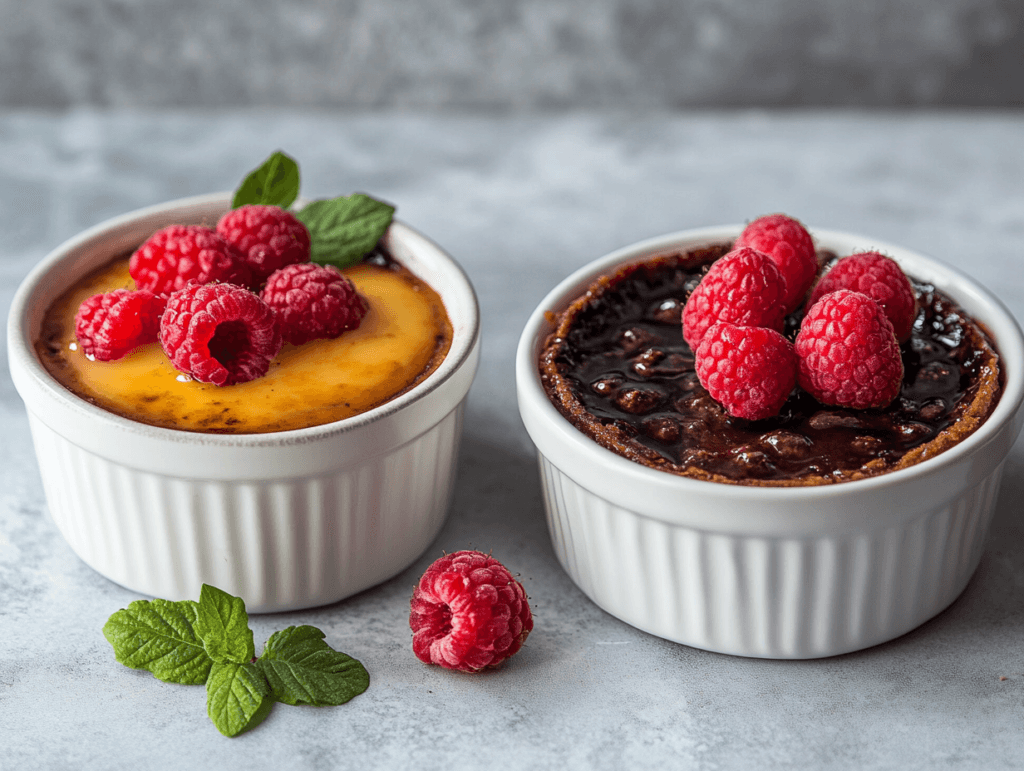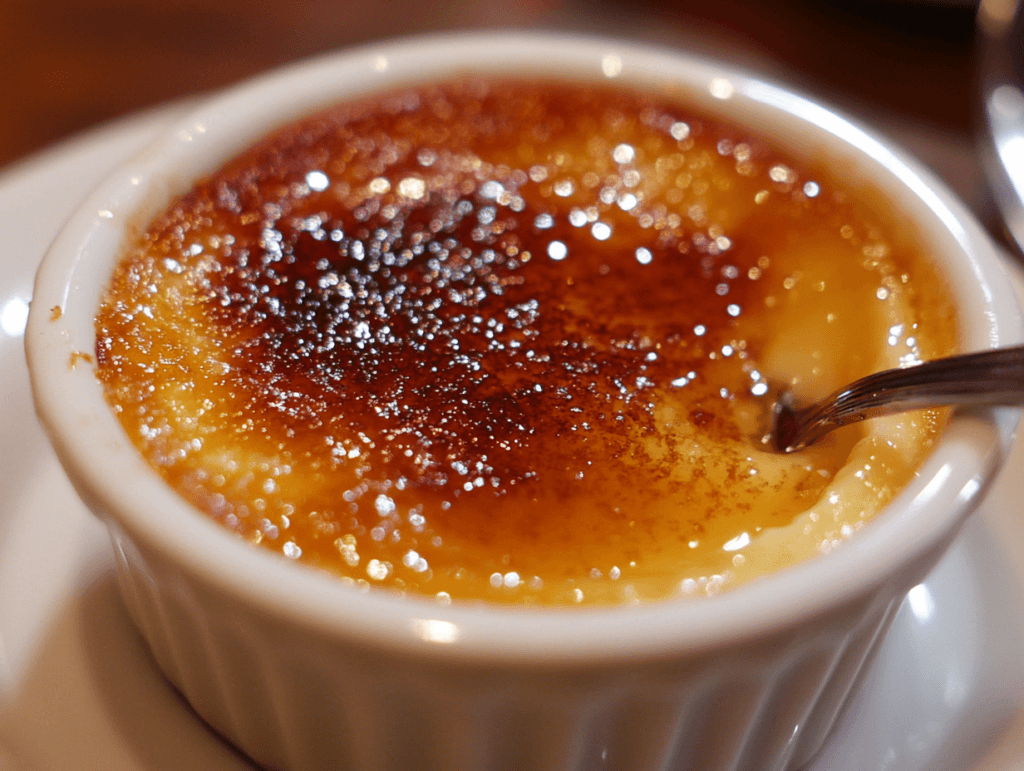What does crème brûlée taste like? This classic French dessert is known for its smooth, creamy custard and caramelized sugar topping, creating a delightful contrast of textures and flavors. The combination of rich vanilla notes and deep caramelized sweetness makes crème brûlée an indulgent and sophisticated treat.
The taste of crème brûlée is a perfect blend of silky custard with a hint of vanilla and a crisp, golden caramelized layer that adds a smoky sweetness. This contrast between creamy and crunchy textures makes every bite a luxurious experience.
In this article, we’ll dive into what makes crème brûlée taste so special, from its flavor profile and texture to the best variations and serving suggestions. Whether you’re new to this dessert or a longtime fan, this guide will help you appreciate why crème brûlée remains a favorite worldwide.
Table of Contents
The Core Components of Crème Brûlée
Each ingredient in crème brûlée plays a key role in its final taste and texture. The heavy cream provides richness, while the egg yolks add smoothness and structure. Sugar enhances the sweetness, and vanilla infuses the custard with a delicate aroma. The caramelized sugar topping is the finishing touch, offering both visual appeal and a satisfying crunch.
What Is Crème Brûlée?
Crème brûlée, which translates to “burnt cream” in French, features a custard base with a caramelized sugar topping. Cream, egg yolks, sugar, and vanilla combine to create the custard, which serves as the heart of its rich and luxurious flavor. These simple ingredients allow their natural flavors to shine, contributing to the refined and balanced crème brûlée taste.
To create the caramelized sugar topping, chefs sprinkle granulated sugar over the set custard and use a torch or broiler to melt it into a hardened, golden crust. This layer contrasts beautifully with the smooth custard below, adding both flavor and texture.
A Glimpse at Its Origins
The roots of crème brûlée can be traced back to 17th-century Europe, with competing claims from France, Spain, and England. Despite its debated origins, crème brûlée has become synonymous with French culinary artistry. The dessert’s elegance and simplicity have made it a staple in fine dining establishments worldwide.
The Art of Preparing Crème Brûlée
Achieving the perfect crème brûlée texture depends on slow baking at a controlled temperature. This ensures that the custard remains silky without becoming overcooked or watery. The sugar topping is caramelized just before serving, ensuring that it remains crisp and flavorful. This careful process is what makes crème brûlée such an enjoyable and sophisticated dessert.
The caramelized sugar topping is prepared just before serving to maintain its signature crispness. When executed perfectly, the process delivers a dessert that balances delicate sweetness with the bold flavor and crunch of caramelized sugar—a hallmark of the crème brûlée taste.
Flavor Profile of Crème Brûlée
Crème brûlée’s flavor profile is a balance of rich and delicate elements. The custard has a buttery, vanilla-infused taste, while the caramelized sugar topping provides a slight smokiness and deep sweetness. This contrast of flavors and textures creates a truly unforgettable dessert.
The Creamy Custard Base
The crème brûlée taste is what makes this dessert a universal favorite. It masterfully blends the rich, creamy notes of its custard base with the bold, caramelized flavor of burnt sugar. This combination creates a sensory experience that is both comforting and indulgent, offering a dessert that is as elegant as it is delicious.
The richness of the cream adds a buttery undertone, making each bite smooth and satisfying. The simplicity of the custard allows the natural flavors of the ingredients to take center stage, making it an elegant and refined choice for dessert lovers.
The Caramelized Sugar Layer
The caramelized sugar topping defines the bold side of the crème brûlée taste. This layer adds a robust, slightly smoky flavor that contrasts beautifully with the custard’s sweetness. As the sugar is torched to a golden brown, it develops a brittle texture that shatters with a delightful crunch in every bite.
This caramelization process enhances the dessert’s complexity, introducing a subtle bitterness that offsets the cream’s sweetness. The result is a flavor profile that is well-balanced and deeply satisfying.
How the Layers Complement Each Other
The magic of crème brûlée is in the combination of textures and flavors. The smooth custard provides a delicate, melt-in-your-mouth experience, while the brittle sugar crust adds an element of crunch. This contrast keeps every bite interesting, making it one of the most enjoyable classic French desserts.
When you take a spoonful of crème brûlée, the smoothness of the custard and the crispness of the caramelized sugar combine in perfect unity. This interplay of textures and flavors is the essence of the crème brûlée taste, making it a dessert that is not just memorable but utterly irresistible.
What does crème brûlée taste like?
While the flavor of crème brûlée is undeniably exceptional, its texture is what elevates it to a truly luxurious dessert. The interplay of creamy custard and the crisp caramelized sugar creates a sensory experience that delights with every bite.
The Contrast Between Layers
Crème brûlée is celebrated for its distinct textural contrast. The top layer of hardened caramelized sugar cracks under the pressure of a spoon, creating a satisfying sound and sensation. This layer gives way to the silky custard beneath, forming a delightful contrast that keeps each bite interesting.
The crispness of the sugar topping provides a welcome crunch, offering a stark but harmonious counterpoint to the smoothness of the custard. This contrast is not just textural but also adds complexity to the dessert’s overall experience.
Silky Smooth Custard
The custard in crème brûlée is its most indulgent component. Achieved through slow baking in a water bath, the custard attains a perfectly smooth and creamy texture. The consistency is dense yet light, melting effortlessly on the tongue.
The use of heavy cream and egg yolks gives the custard a rich, velvety mouthfeel. This texture, combined with its gentle sweetness and subtle vanilla notes, makes it incredibly satisfying without being overwhelming.
Crisp and Crunchy Topping
The caramelized sugar topping is more than just a visual and flavor element—it’s a crucial textural component. When torched, the sugar melts and then cools to form a glassy, brittle layer that adds a pleasant crunch to each bite.
The hardness of the sugar provides a stark contrast to the custard, creating a dynamic eating experience. Breaking through the sugar crust is one of the most enjoyable parts of indulging in crème brûlée, offering a tactile and auditory reward before you even taste the dessert.
Variations in Crème Brûlée Flavors

Modern chefs have introduced exciting variations of crème brûlée, infusing the custard with new and bold flavors. Whether it’s dark chocolate for a richer experience, citrus zest for a refreshing twist, or espresso for a coffee-inspired version, crème brûlée can be adapted to suit any taste preference.
Classic Vanilla Crème Brûlée
The traditional crème brûlée highlights rich, floral notes of vanilla. Chefs often use whole vanilla beans or high-quality vanilla extract to achieve this signature flavor. The natural sweetness of vanilla complements the custard’s creamy texture perfectly, resulting in a dessert that feels both simple and sophisticated.
This classic version is the most recognizable form of crème brûlée and serves as the foundation for many modern twists. Its timeless appeal makes it a favorite choice for both special occasions and casual indulgence.
Modern Twists: Chocolate, Fruit, and More
Modern chefs have embraced the versatility of crème brûlée, experimenting with flavors to create unique and exciting versions:
- Chocolate Crème Brûlée: For chocolate crème brûlée, chefs blend rich cocoa or melted chocolate into the custard, creating a decadent dessert with a deeper, more indulgent flavor.
- Citrus Crème Brûlée: Infusions of lemon, lime, or orange zest add a zesty brightness that cuts through the richness of the custard.
- Espresso or Coffee Crème Brûlée: The bold flavor of coffee brings a sophisticated, slightly bitter edge to the dessert, making it a favorite among coffee lovers.
- Fruit-Flavored Crème Brûlée: Purees of raspberry, passion fruit, or mango introduce fruity notes, adding sweetness and tartness to the creamy base.
These variations maintain the classic texture of crème brûlée while offering a fresh twist on its flavor profile.
Regional and Seasonal Variations
Crème brûlée also adapts to regional and seasonal influences. In some cultures, local spices like cardamom or cinnamon are added to give the dessert a unique flavor. Seasonal variations, such as pumpkin crème brûlée in autumn or peppermint crème brûlée during the holidays, make the dessert relevant to different times of the year.
These variations highlight the versatility of crème brûlée, proving that its core concept can be endlessly reimagined while retaining its charm.
Pairing Crème Brûlée with Other Foods

The versatility of crème brûlée makes it an excellent choice for pairing with beverages and complementary flavors. A cup of espresso or cappuccino can enhance its rich taste, while a glass of sweet dessert wine like Sauternes or Moscato pairs beautifully with its caramelized sugar topping. Fresh berries or dark chocolate also make excellent accompaniments, adding an extra layer of flavor.
Ideal Beverage Pairings
The richness of crème brûlée pairs beautifully with various beverages, each enhancing the dessert’s flavors in unique ways:
- Coffee or Espresso: The bitterness of coffee or a strong shot of espresso contrasts wonderfully with the custard’s sweetness, balancing the palate.
- Dessert Wines: Sweet wines like Sauternes, Moscato, or Tokaji complement the caramelized sugar topping with their fruity and honeyed notes.
- Champagne or Sparkling Wine: The light, bubbly texture of sparkling wines cuts through the creaminess of the custard, providing a refreshing counterbalance.
- Tea: Herbal teas, especially those with floral or citrus profiles, offer a delicate pairing that complements the vanilla and caramel flavors.
Serving Crème Brûlée as Part of a Meal
As a rich and indulgent dessert, crème brûlée works best when served after a lighter main course. A savory dish, such as grilled fish or a crisp salad, provides a nice contrast to the dessert’s creamy sweetness.
Crème brûlée can also serve as the centerpiece of a dessert platter, accompanied by small pastries, cookies, or fresh fruit. These additions create a varied and satisfying end to any meal.
Balancing Sweetness with Other Desserts
For those who enjoy variety, pairing crème brûlée with other desserts can add depth to the dining experience. Consider these combinations:
- Fresh Berries: The tartness of raspberries, blackberries, or strawberries complements the custard’s sweetness while adding a refreshing burst of flavor.
- Dark Chocolate: A small piece of bittersweet chocolate or a truffle enhances the caramelized sugar’s smokiness.
- Cheese Plate: Surprisingly, a mild cheese plate with honey or fig preserves can offer a sophisticated contrast to crème brûlée.
These thoughtful pairings not only enhance crème brûlée but also showcase its versatility as a dessert that can adapt to various occasions and preferences.
Frequently Asked Questions About Crème Brûlée
What Makes Crème Brûlée Unique?
The hallmark of crème brûlée lies in its contrast of textures and flavors. Technique of caramelizing sugar to form a crisp top layer is key to achieving its signature appeal.
Is Crème Brûlée Always Sweet?
While traditionally sweet, crème brûlée can be transformed into a savory dish. For instance, chefs have created savory versions like crab brûlée, showcasing its adaptability to a variety of tastes.
How Is Crème Brûlée Best Served?
This dessert is best enjoyed slightly chilled with the caramelized sugar freshly torched to maintain its crispness. For a gourmet twist, explore recipes like crab brûlée that highlight unconventional ways to enjoy this dish.
Can You Make Crème Brûlée at Home?
Yes! Crème brûlée can be made at home with basic ingredients and tools. A culinary torch is recommended for achieving the perfect caramelized topping, but a broiler can also work in a pinch.
How Does Crème Brûlée Compare to Similar Desserts?
Crème brûlée shares similarities with desserts like flan and crema catalana but differs in its preparation and texture. The hardened caramelized sugar layer is unique to crème brûlée, giving it a distinctive crunch.
Conclusion
Crème brûlée is more than just a dessert—it’s a luxurious treat that combines simplicity with sophistication. Whether you enjoy the classic vanilla version or prefer to explore new and creative flavors, its perfect balance of texture and taste makes it an all-time favorite among dessert lovers. If you haven’t tried making it at home, now is the perfect time to experience this iconic French indulgence.
You can savor the classic vanilla version or try modern twists. The crème brûlée taste offers a luxurious and deeply satisfying experience. Its unique flavor and the contrast between silky custard and crisp topping make it a staple on dessert menus. This beloved treat leaves a lasting impression on all who try it.

